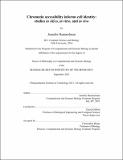Chromatin accessibility informs cell identity: studies in silico, in vitro, and in vivo
Author(s)
Hammelman, Jennifer
DownloadThesis PDF (16.72Mb)
Advisor
Gifford, David
Terms of use
Metadata
Show full item recordAbstract
Chromatin accessibility provides key regulation in defining cell identity as it exhibits control over the ability of transcription factors and transcriptional machinery to bind to regulatory elements and initiate changes to gene expression. In this thesis I elaborate on the intricate relationships between genome sequence, cell type-specific chromatin accessibility, and cell reprogramming to specific fates. The first chapter focuses on an investigation in vitro of the relationship between DNA sequence and chromatin accessibility through the development of a novel massively parallel reporter assay for chromatin accessibility. In collaboration with Budhaditya Banerjee and Rich Sherwood, we identify DNA sequence features and subtle influences of transcription factor ordering within a sequence for tuning levels of cell typespecific chromatin accessibility. The second chapter develops methodology to identify significant cell type-specific DNA sequence patterns such as transcription factor motifs or grammar such as transcription factor spacing or combinations from deep learning models trained to predict chromatin accessibility from DNA sequence. The third chapter evaluates nine computational methods for ranking reprogramming transcription factors from known reprogramming protocols, and optimizes each method to explore 150 alternative strategies for ranking reprogramming transcription factors. In the final chapter of this thesis, in collaboration with Tulsi Patel and the Wichterle lab, I apply our novel methods and understanding of best practices to investigate chromatin accessibility and gene expression changes during mouse motor neuron maturation in vivo. Using a time-series of RNA-seq and ATAC-seq collected from embryonic, juvenile, and adult stages of mouse motor neuron development, we find that chromatin accessibility and gene expression changes become static as mice reach adulthood, find that maturation is characterize by both cell type-specific and shared maturation programs, and identify potential transcription factor targets for functional neuronal maturation.
Date issued
2021-09Department
Massachusetts Institute of Technology. Computational and Systems Biology ProgramPublisher
Massachusetts Institute of Technology